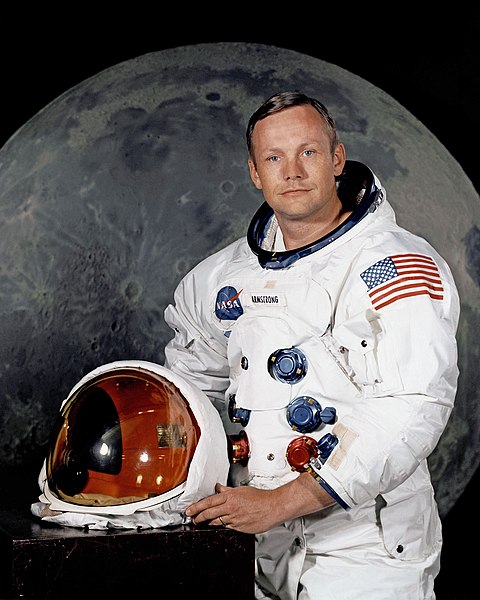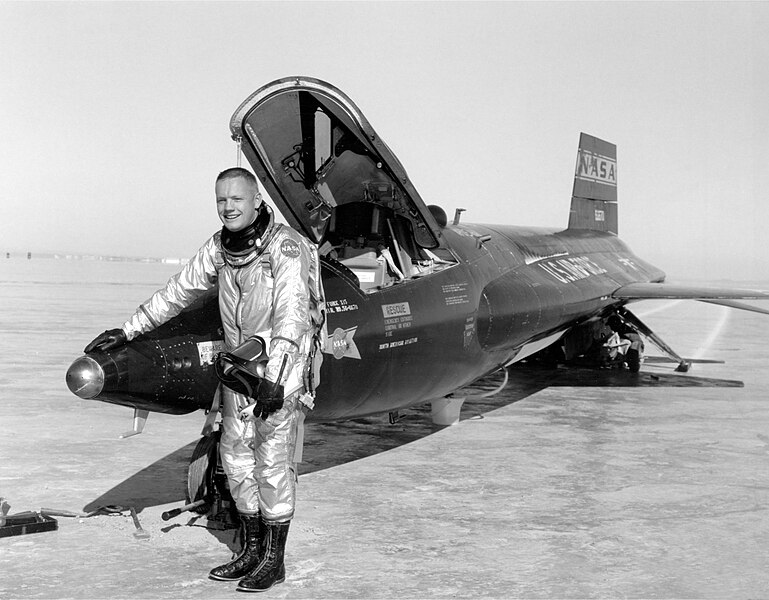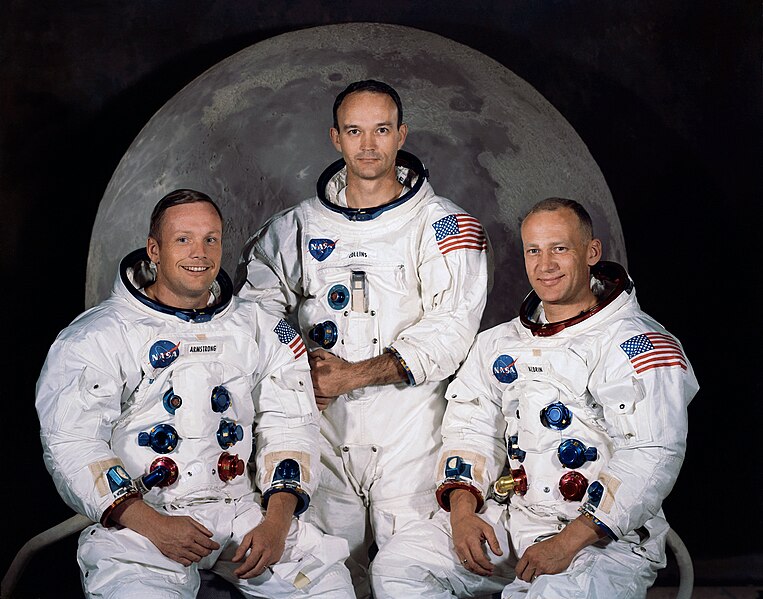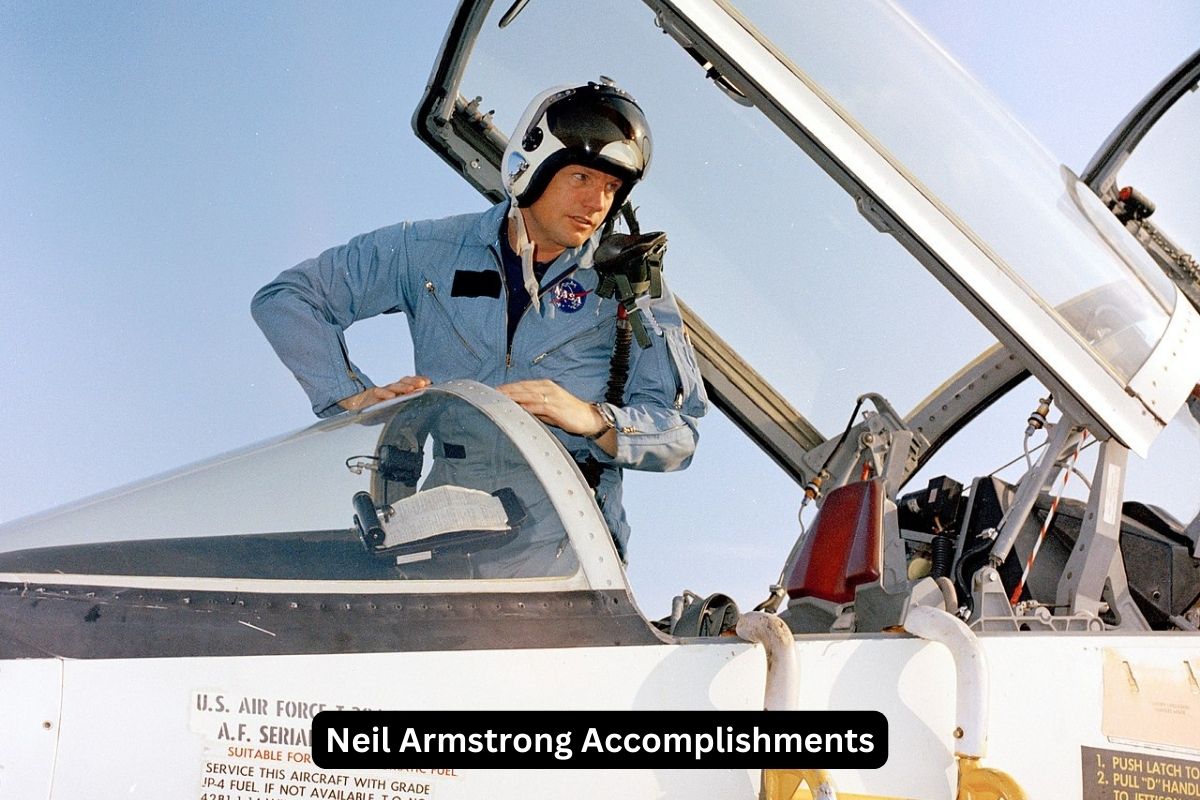Neil Armstrong, an iconic figure in the annals of space exploration, achieved worldwide recognition as the first human to set foot on the Moon during NASA’s historic Apollo 11 mission in 1969.
However, his illustrious career encompassed far more than this momentous achievement.
Armstrong’s journey from an aeronautical engineer and test pilot to a renowned astronaut and advocate for science and education is a testament to his significant contributions to space exploration and aviation.
In this overview, we will delve into some of his most notable accomplishments that highlight the remarkable life and career of Neil Armstrong.
Accomplishments of Neil Armstrong
1. First human on the Moon (Apollo 11, 1969)
Neil Armstrong’s most iconic accomplishment was being the first human to set foot on the Moon on July 20, 1969, during NASA’s Apollo 11 mission.
Also Read: Neil Armstrong Timeline
This historic event marked a giant leap for humanity and solidified Armstrong’s place in history. His words, “That’s one small step for man, one giant leap for mankind,” as he descended from the lunar module, are etched in the collective memory of humanity.

2. Successful docking in space (Gemini 8, 1966)
Before his famous lunar landing, Armstrong served as the command pilot on NASA’s Gemini 8 mission in 1966. This mission was significant because it achieved the first-ever successful docking of two spacecraft in orbit.
Armstrong’s piloting skills and ability to troubleshoot a critical spacecraft issue, which involved a stuck thruster, demonstrated his exceptional calmness and competence under pressure.
3. Test pilot for NACA and NASA
Neil Armstrong’s career as a test pilot played a pivotal role in his selection as an astronaut. Before joining NASA, he worked as a test pilot for the National Advisory Committee for Aeronautics (NACA), which later became NASA.
Also Read: John Glenn Facts
As a test pilot, Armstrong flew a variety of experimental aircraft, pushing the boundaries of aviation technology and contributing to the development of new aircraft designs and technologies.
His experience and expertise as a test pilot made him an ideal candidate for NASA’s astronaut program, where he continued to make significant contributions to the field of space exploration.
4. Flights on the X-15 research aircraft
Neil Armstrong was one of the select few astronauts who had the privilege of flying the X-15 rocket-powered aircraft.
The X-15 was a groundbreaking experimental aircraft designed to explore high-speed and high-altitude flight. Armstrong flew a total of seven X-15 test flights between 1960 and 1962.
These flights helped researchers and engineers gather crucial data on aerodynamics and materials at the edges of Earth’s atmosphere, contributing to advancements in spaceflight and aviation technology.

5. Aeronautical engineer
Armstrong earned a Bachelor of Science degree in aeronautical engineering from Purdue University in 1955. His educational background and engineering expertise were essential in his career as an astronaut and test pilot.
His deep understanding of aircraft and spacecraft systems made him a valuable asset to NASA and contributed to the success of the Apollo program.
6. Lunar Module Pilot for Apollo 11
During the historic Apollo 11 mission to the Moon, Neil Armstrong served as the Lunar Module Pilot. This role involved piloting the lunar module, named “Eagle,” down to the lunar surface and ensuring a safe landing.
Armstrong’s precise piloting skills and ability to handle unexpected challenges during the descent were critical to the mission’s success. His calm and composed demeanor under the intense pressure of landing on the Moon contributed to the safe touchdown and made the historic moment possible.
Armstrong’s role as the Lunar Module Pilot paved the way for his historic first steps on the lunar surface and solidified his place as a pioneering figure in human space exploration.

7. Conducted experiments and collected samples on the Moon
While on the Moon during the Apollo 11 mission, Neil Armstrong and Buzz Aldrin conducted a variety of activities and experiments. Some of their notable accomplishments during their moonwalk included:
- Collecting lunar surface samples: Armstrong and Aldrin collected rock and soil samples from the Moon’s surface, which were brought back to Earth for scientific study.
- Setting up scientific instruments: They deployed the Early Apollo Scientific Experiments Package (EASEP), which included a seismometer to measure moonquakes, a laser reflector for precise distance measurements, and other instruments to gather data about the lunar environment.
- Taking photographs and videos: Armstrong and Aldrin documented their activities, the lunar landscape, and Earthrise from the Moon’s surface, providing valuable visual records of the mission.
8. Set up scientific equipment on the Moon (EASEP)
As the Lunar Module Pilot for Apollo 11, Neil Armstrong played a pivotal role in deploying the Early Apollo Scientific Experiments Package (EASEP) on the lunar surface.
This package consisted of various scientific instruments designed to gather data and conduct experiments to enhance our understanding of the Moon’s environment and geology. Some of the key components of EASEP included:
- Laser Ranging Retroreflector (LRRR): One of the most well-known components of EASEP, the LRRR was a device equipped with small prisms that could reflect laser beams sent from Earth. This allowed precise measurements of the distance between the Earth and the Moon, contributing to studies of lunar orbit and the Earth-Moon system’s dynamics.
- Passive Seismic Experiment (PSE): This instrument aimed to detect and record seismic activity or moonquakes. It consisted of seismometers placed on the lunar surface, and it provided valuable data on the Moon’s interior structure and seismic activity.
- Solar Wind Composition Experiment (SWC): SWC collected and analyzed the solar wind’s composition, which is the stream of charged particles emitted by the Sun. Understanding the composition of the solar wind helped scientists learn more about the Sun and its influence on the Moon’s surface.
- Solar Wind Spectrometer (SWS): This instrument measured the energy, direction, and composition of the solar wind, providing crucial data for solar physics and planetary science.
- Suprathermal Ion Detector (SID): SID measured the properties of ions in the Moon’s exosphere, helping researchers understand the interactions between the Moon and the solar wind.
9. Contribution to the Space Shuttle program.
After retiring from NASA in 1971, Neil Armstrong continued to play a role in space exploration. He was involved in the development of the Space Shuttle program, serving as the Deputy Associate Administrator for Aeronautics at NASA Headquarters. His insights and experience were valuable in shaping the future of human spaceflight.
10. Received awards, including the Presidential Medal of Freedom
Neil Armstrong received numerous awards and honors throughout his lifetime in recognition of his significant contributions to space exploration and aviation. Some of the notable awards and honors he received include:
- The Presidential Medal of Freedom: The highest civilian award in the United States, awarded to Armstrong in 1969 by President Richard Nixon.
- The Congressional Space Medal of Honor: Awarded by the U.S. Congress in 1978 for his exceptional contributions to space exploration.
- Induction into the International Air & Space Hall of Fame: Armstrong’s achievements in aviation and space earned him a place of honor in this prestigious hall of fame.
